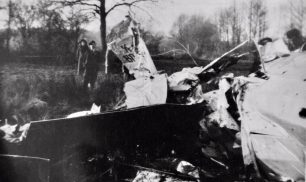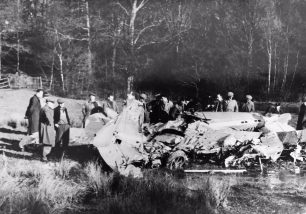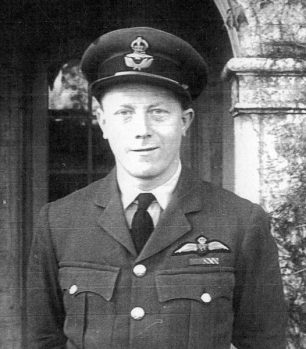Sgt. Geoffrey Edwin Gaskell - The 'Missing Man' in Airmen's Corner
At around 9.25am on 17th January, 1938, three Gloster Gladiators of No.65 Squadron took off from their base at RAF Hornchurch for formation flying practice. The flight had been ordered by F/Lt. Leslie Charles Bicknell so that a relatively inexperienced pilot, Sergeant Geoffrey Edwin Gaskell, could get some formation practice with two of the squadron’s more accomplished flyers – Pilot Officer Adrian Hope Boyd and Pilot Officer Roland Robert Stanford Tuck.
Flying at around 6000ft near Uckfield, Sussex, the three aircraft were moving into line astern formation with Boyd leading and Tuck at the rear. The Gladiators were positioned slightly above and to the right of each other, to avoid the turbulent slipstream from the aircraft in front. Their propellers were within 10 yards of the rudder of the aircraft in front. There was a high wind and Gaskell’s aircraft bucked in a gust, he over-corrected, swung to the left and dropped down slightly, placing himself in Hope-Boyd’s slipstream, which threw him over into a steep bank. Tuck was easing off the throttle and trying to fall back when Gaskell made the fatal mistake of breaking away to the right, bringing his aircraft directly into the path of Tuck’s. The two machines were almost at right angles and a collision was unavoidable.
Larry Forrester described the impact in his biography of Stanford-Tuck:
The noise was like a splitting oak. Tuck’s propeller sheared through the fuselage of the other plane close behind the canopy, and almost certainly sliced into Gaskell’s head and back. Beyond Bob’s windscreen there was nothing but writhing sheets of fabric and buckling metal airframe. The wings buckled and wrapped themselves around the hood, enveloping him with the finality of a shroud.
The crumpled wings prevented Tuck from opening the canopy to bail out of his spinning Gladiator. In desperation, he stood on the bucket seat, and, bent double, got his shoulders under the hood, pushing upwards with no result. The instrument panel collapsed when he tried bracing his feet against that and he remained trapped in the cockpit until the tightening spin tore both the wreckage and the canopy off the fuselage. He was thrown from the cockpit and managed to deploy his parachute at about 300 feet above the ground. While still in the air, he realised that he was bleeding profusely from a large wound on the right side of his face. He injured his ankle as he hit the ground in a field at Croxted Farm, near Iron Pear Tree Corner, Mount Ephraim. He was unable to stand, but help soon arrived in the shape of some farm workers and he was taken by ambulance to the Cottage Hospital. Tuck spent six days in hospital and emerged with a long scar down the side of his face and a slight limp.
Tuck’s Gladiator, K7940, was found in a marsh on Captain G. V. Baxendale’s estate at the north end of New Road, Ridgefield, with parts of Gaskell’s fuselage and tail still jammed onto the front of it.
A local policeman saw Gaskell’s body fall from his tailless Gladiator (K8014) which plummeted earthwards “like a log” and crashed through the roof of a barn at Messrs. Piper’s nurseries near Lewes Rd. A boy who had been chopping wood in the barn not long before had a lucky escape.
Geoffrey’s body was found at Ridgewood allotments, just over the boundary hedge of the recreation ground with part of the cockpit around his neck. He had made no attempt to open his parachute and the inquest into his death concluded that he had died in the air of a fracture to the base of the skull and many other injuries.
The RAF took charge of the crash sites during the afternoon and the wreckage was recovered to RAF Kenley the following day. It seems likely that Kenley also took charge of Gaskell’s body. The 24-year-old pilot had joined the RAF in 1930, but had only been flying for about a year at the time of his death. He was laid to rest in Airmens’ Corner at St. Luke’s, Whyteleafe, on 20th January, in the presence of 100 Officers and men of 65 Squadron, Hornchurch. RAF Kenley provided a firing party and his coffin, draped in the Union flag, was borne on a gun carriage drawn by an RAF waggon.
GEOFFREY EDWIN GASKELL was born, together with his twin brother Kenneth Gordon, on 16th April, 1913, in Bristol. Their parents, Joseph Gaskell and Alice Maud Gaskell (nee Jenkins) already had three children: Josephine, Cyril and Annette.
Geoffrey’s father, Joseph Gaskell was born in 1864. He worked as a clerk before joining the Army in 1886 and served with the 11th Hussars in South Africa (1890), India (1892) and Egypt (1899) rising to the rank of Sergeant Major. In 1902, Joseph married Alice Maud Jenkins, at St. John’s, Southall. She lived at “The Black Dog” public house, where her widowed mother was publican and she worked behind the bar with her brother. In 1906, the Gaskells lived at 36 Birch Rd, Ashton Gate, Bristol. In 1911, prior to the arrival of the twins, the family had moved 45 Greville Rd, Bristol, with one servant working as “Mother’s help.”
Joseph was discharged in 1914 with a view to being appointed to a commission in the North Somerset Yeomanry and died in 1917 in Colchester Military Hospital, aged 53, while serving as Lieutenant Quartermaster, Household Cavalry and Cavalry of the Line. In total, he spent more than 30 years in the British Army. His residence was Cornwall House, Bishopsworth, near Bristol, at the time of his death. The family were still living there when Cyril died, aged 24, in 1930. Geoffrey’s mother, Alice died in 1936, aged 57, and his sister, Annette, passed away in Ham Green Sanatorium, probably of tuberculosis, on 28th October, 1937, aged 26, only a few short months before Geoffrey had his fatal flying accident.
Geoffrey was educated at Victoria College, a boys’ school near Bath He enlisted in the RAF in January 1930, and won great distinction for his marksmanship, as well as being a fine hockey and tennis player. Prior to his time at RAF Hornchurch with 65 Squadron, he had been stationed at Filton.
At the time of Geoffrey’s death, his twin brother Kenneth was serving in the Royal Navy aboard HMS Royal Oak. However by 1939, he was working as a teleprinter operator for the Royal Army Ordnance Corps and appears to have been a Lance Bombardier in a Light Anti-Aircraft unit of the Army Reserve (1939 Register). It appears that he too succumbed to tuberculosis in St. Michael’s Home, Axbridge, in 1946, aged 33. The only one of Joseph and Alice’s children to survive to a great age was their first born, Josephine, who died in 1998, aged 94.
Rest in peace Geoffrey and thank you for your service.
Many thanks to Colin Lee for photos.
















No Comments
Add a comment about this page